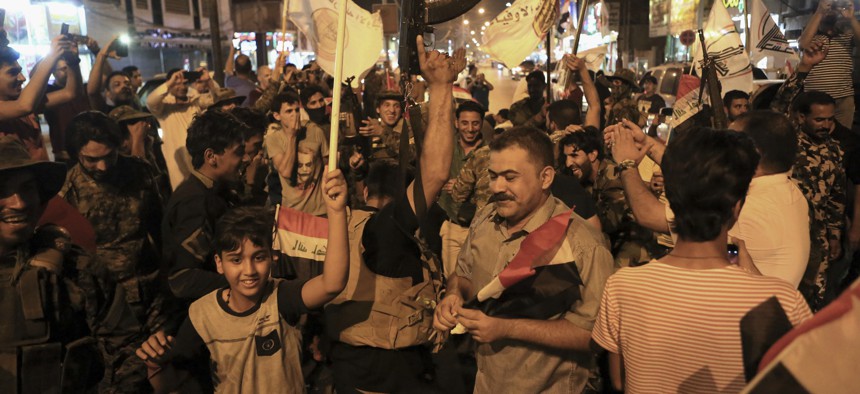
Iraqi security and civilians celebrate while holding national flags as they wait for the final announcement of the defeat of the Islamic state militants, in Basra, 340 miles (550 kilometers) southeast of Baghdad, Iraq, Sunday, July 9, 2017. AP / NABIL AL-JURANI
Flow of Foreign Fighters to ISIS Stopped, Trump Tactics Working, McGurk Says
In four key areas, the Trump administration is taking the fight to ISIS in a way that Obama did not, to great effect according to the policy head who worked under both.
The flow of foreign fighters trying to join ISIS in Iraq and Syria has stopped completely. “They can’t get in now and the foreign fighters that did get in, they will die in Iraq and Syria” according to the top U.S. official coordinating the international fight against the terrorist organization.
That’s just one of several metrics to show that under the Trump administration the United States-led coalition is accelerating the demise of the Islamic State group, or ISIS, by changing strategies and doubling down on others, argued Brett McGurk, special presidential envoy for the Global Coalition to Counter ISIS, at the Middle East Institute on Thursday
To date, the multinational 73 member coalition against has cleared 70,000 square km and freed 5 million people under ISIS control, he said.
In Iraq, the United States and allies had trained nearly 100,000 Iraqi Security Force, or ISF, personnel for the fight for Mosul. The new ISF is very different from the Iraqi forces that abandoned their posts, equipment, and even uniforms in 2014 as ISIS struck Mosul, McGurk said.
“The units we have trained have never lost a battle” he said. That included the tough, house-by-house urban warfare fighting in Mosul where, he says, ISF persisted despite suffering high casualties against “hundreds of foreign fighters that were barricaded with the civilian population, using them as shields.”
Related: The Islamic State’s Caliphate Is Finished in Iraq, Abadi Says
In Syria, efforts by the U.S.-backed Syrian Democratic Force, or SDF, to push ISIS out of Raqqa were already “40 percent finished.” (He did not say if that specifically meant that 40 percent of the city was now under SDF control.) The coalition in the months ahead plans to link up eastern and western forces in key areas.
Map of the battle of Raqqa, 24.07.2017 pic.twitter.com/xrvXncyVXf
— Gargari (@Gargaristan) July 24, 2017
The SDF has grown to 25,000 Sunnis and 25,000 Kurds. The Sunni-Arab component of the SDF was growing particularly rapidly, he said, and “all training classes were full.”
McGurk outlined four changes since Trump took office that are costing ISIS on the ground.
The most important change under Trump, according to McGurk, was to delegate more tactical decisions to commanders farther down the chain of command from the National Security Council in Washington. including to the war’s top commander, Lt. Gen. Stephen Townsend, commander of the Combined Joint Task Force for Operation Inherent Resolve, or CJTF-OIR.
“The reason we’re 40 percent through Raqqa now is because we seized that opportunity. That quick, rapid turn decision makes a difference,” McGurk said.
McGurk described how last spring one group of local forces pitched the general on an “audacious military maneuver” across 8 km of water. They requested helicopter air-lift, believing that they could launch a surprise attack to take the Tabqa dam and the surrounding area. The operation “was high risk. It was audacious. But because Townsend had that authority he was able to approve it almost immediately.” The operation, which took place in May, was a success.
On the strategic front, McGurk credited Defense Secretary James Mattis’s strategy of “surround, constrict, annihilate.” Mattis, in May, announced the U.S.-coalition’s plan to surround ISIS in pockets and not permit fighters, particularly foreign fighters, to escape. “Our intention is that the foreign fighters do not survive the fight to return home to North Africa, to Europe, to America, to Asia, to Africa. We're not going to allow them to do so. We're going to stop them there and take apart the caliphate,” said Mattis.
Related: New Tactics, Quicker Decisions Are Helping to ‘Annihilate’ ISIS, Pentagon Says
The Trump administration is also “accelerating” some measures that the Obama administration began, according to McGurk. These include putting a greater emphasis on getting other governments in the international counter-ISIS coalition to contribute more funding. Right now, for every dollar the United States contributes to stabilizing territory won from ISIS, other coalition members, such as Saudi Arabia, contribute three. “We’re going to grow that ratio in the coming months,” McGurk said.
The Obama administration also began a process of attempting to sever financial links between ISIS in Raqqa and its affiliates around the world. The U.S. State Department under Trump will look to “accelerate wherever we can” the severing of financial nodes between ISIS and franchise operations around the world.
McGurk declined to answer broader questions about how Iran and Russia were consolidating gains in Syria, or what the defeat of ISIS meant for a possible resurgence of al-Qaeda in the region or globally, preferring to focus on ISIS and what he described as a policy against them that was working.
“We cannot take our boot off the throat of this enemy,” he said.




